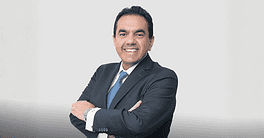Skies are brightening for advanced economies, but emerging markets face extra challenges post-Covid.

Unique for many reasons, the pandemic-induced economic crisis is not finished. Despite a sharp economic recovery in China and in the United States and progress with vaccines, the pandemic still casts a gloomy shadow over the global economy—and it looks like gray skies for a while.
“My main worry is still that the pandemic is not over. I think people are underestimating the risks involved,” Marcel Fratzscher, president of the DIW Berlin economic research institute, tells Global Finance. “In Germany and other parts of Europe, there’s a feeling that the pandemic will be over soon. This is a dangerous illusion.”
Backed by once-in-a-lifetime government largesse and super-lax monetary policy, GDP in the United States and China was roaring back with unusual strength at the end of 2020. That growth will help power a global rebound of 6% in 2021, followed by another expansion of almost 5% in 2022, according to the International Monetary Fund. Somewhat surprisingly, productivity surged.
Of course, prospects vary widely around the globe, due to differing policy moves, social and environmental conditions and exposure to variants. “You have a rebound everywhere, but it’s still a very uneven recovery,” says Elena Duggar, chair of Moody’s Macroeconomic Board. “The pace of vaccinations and pandemic management are in the driver’s seat of the economic recovery.”
Duggar adds that while the G20 countries are expected to reach a threshold of 70% of the population vaccinated by the end of 2021, some low-income countries, many of them in Africa, won’t get there for another two years, around the end of 2023. “This is a global pandemic,” says Duggar. “Until it’s under control everywhere, you will continue getting additional variants and new pandemic waves.”
Even in those places where the economy is relatively strong, such as the US, new variants and human vaccine resistance are blocking a complete return to school and work—which many expected in September. Instead, the month saw macroeconomic softening in countries where recovery had arrived first, including a slowdown in job creation. “I think people are underestimating the risks,” says Fratzscher.
It is difficult to say how long Covid will stay and whether it will become more virulent, less virulent or totally disappear. “I am an economist, not an epidemiologist,” says Tim Kehoe, professor of economics at the University of Minnesota. “What I do know is that the uncertainty really changed the picture in the past three months, and the Delta variant has tempered projections. It is possible that the fourth-quarter 2021 is not going to be as good as we expected.” On the other hand, he adds, “that means 2022 might be even better.”
Productivity Surprise
Paradoxically, despite lockdowns, productivity rose under Covid-19. After averaging only 1.3% annually since 2006, around half of its rise in the previous decade, productivity rose 4.3% in the first quarter of 2021, settling back to 2.1% in the second quarter, according to the US Bureau of Labor Statistics.
Some of the improvement may be attributed to the shuttering of low-productivity work in service industries, but more important in the long run, requirements for social distancing motivated companies to accelerate investment in digital technology while employees and customers accelerated their adoption of the same. Will the combination unleash new potential? “The digital shift started before the pandemic, but the pandemic has given to it a major boost,” says Duggar. “It is still an open question how increased digitization will play out, in terms of boosting productivity or not.”
Some signs point to opportunity. A large-scale study of over 50,000 Americans by economists Jose Maria Barrero, Nicholas Bloom and Steven J. Davis, shows that remote working is likely to stick at large companies post-pandemic, at least a few days per week, because—against the expectations of many—it’s a bottom-line booster. “Forty percent of the people we spoke to said that they are more productive at home than at the office,” says Barrero, a professor of finance at the Instituto Tecnologico Autonomo de Mexico Business School. “And they seem to like it.”
The first, immediate, factor is the value of the time and effort formerly expended on travel between home and office. Some employees redeploy that time to professional tasks, working a longer day. Others find that the additional time leaves them with more energy and focus for their jobs. A hefty majority of respondents—around 75%—say they are more efficient because they are not commuting, Barrero says.
Few agree that isolated working conditions are ideal. “The doubt that lots of economists have is that we know people learn from working with their coworkers,” says Kehoe. The unprecedented pace of technological change—robotics, AI [artificial intelligence] and other digitally driven tools have transformed multiple industries—makes that even more important in order to fully tap into technology’s potential. “When you start introducing new technologies, first productivity goes down because people have to learn; but then productivity goes up,” says Kehoe. Considering the many advances in digital communications and AI implemented under remote work conditions, he adds “We might not yet have seen the boom in productivity.”
Those considerations move Barrero and others to support a hybrid model, in which workers spend some days in the office and some days at home, as the best long-term solution. This unleashes some value from commuting time while still ensuring colleagues have regular in-person interactions and opportunities to learn from each other.
Policy Space
For the coming months, the spotty, multispeed, uncertain economic recovery around the globe will keep monetary and fiscal authorities on their toes. Liberal government-spending plans and record low interest rates are more likely to remain in place for longer—at least in the richest countries that can better afford the accumulation of future debt and heightened inflationary risks.
“Countries still face lingering difficulties with the pandemic, risk of a tightening in global financial conditions and the buildup of public and private debts,” Brazil’s central bank governor, Roberto Campos Neto, tells Global Finance. “All these factors affect emerging economies especially, including Brazil.” Since March, several Latin American central banks—notably Brazil, Mexico and Peru—have raised interest rates to counter rising inflation, and more rate hikes are expected.
As a result of the pandemic, debt rose to unseen levels, creating an element of instability that will most likely affect emerging and the poorest countries first. “We do worry about the debt,” says Moody’s Duggar. “In both advanced and emerging countries it is reaching unprecedented levels. We are above the peaks after the Second World War in advanced economies.” What’s more, she adds, “The buildup in debt is very broad, across advanced economies and emerging markets, across sovereigns and across corporates.”
Nevertheless, she notes, with interest rates still at record lows, debt-servicing ability in advanced economies remains strong. The bulk of risks are in the Caribbean and Africa, says Duggar, “more in smaller emerging markets than larger ones.”
Central banks such as the US Federal Reserve, the European Central Bank (ECB) and the Bank of Canada—with longer and more-credible records of fighting inflation—are more likely to delay tightening policy, especially with more uncertainty from the supply side. The Fed signaled some tapering at the end of 2021 and a first increase in rates during the second half of 2022. For Europe, where inflation has been lower than the ECB target, tightening is not expected until 2024, despite rising price pressures and production bottlenecks. An EU parliamentary statement in mid-September looked on recent inflation spurts as largely transitory, while acknowledging a range of potential risks on the horizon.
“The takeaway for us is that the fundamental recovery story remains intact. We have had extremely strong policy responses to this pandemic; and because of that, the drivers of demand, most importantly income, look likely to remain strong,” says Andrew Schneider, a US economist at BNP Paribas. “While in the near term we think supply chain issues will weigh on growth, we think we’ll eventually see pent-up supply released and this near-term growth shortfall recouped.”
As a result, inflationary risks present new problems for policymakers. “It’s a more challenging backdrop for central banks, and there’s variation among the reactions of different central banks. Advanced-economy central banks are coming from a long period of low inflation. In the near term, their priorities should continue to be stabilizing economic output rather than tackling inflation,” Schneider adds. “For emerging-market central banks, instead, the lack of inflation credentials means that policy tightening is a likely response.”
Most economists consider the current spike in US inflation—this spring and summer it was rising at the fastest pace in 13 years—seeming to peak in August according to Reuters, tied to supply chain disruptions due to the pandemic. A variety of commodities, such as oil and lumber, have seen their prices jumping sharply higher because of bottlenecks in production or distribution. The cost of mayonnaise has skyrocketed because its main ingredient, soybean oil, has almost doubled in the last 12 months. That does not mean the price of mayonnaise will keep climbing.
“There are different sources of inflation; and they are either arithmetic in nature, or related to reopening or to the pandemic,” says Simon MacAdam, senior global economist at Capital Economics in London. “Over time these disruptions can ease, and supply can bounce back to meet demand.”
Massive public spending plans—for infrastructure in the US and the NextGenerationEU recovery package in Europe—should provide an important motor of growth. That will mostly depend on how the money is spent.
“I think the single highest-return investment opportunity for the US right now is a major Marshall Plan for Covid containment,” economist and former US Treasury Secretary Larry Summers said in a September interview. “Beyond the moral case … no one is safe until everyone is safe, because of mutations. There are the further considerations that there is no better way for us to garner international goodwill, contrasting ourselves favorably with China, or assure the world is ready for the next pandemics that will surely come.”



